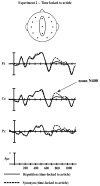An electrophysiological investigation of the effects of coreference on word repetition and synonymy
- PMID: 15896394
- PMCID: PMC3581343
- DOI: 10.1016/j.bandl.2005.01.001
An electrophysiological investigation of the effects of coreference on word repetition and synonymy
Abstract
In two experiments the effects of word repetition, synonymy, and coreference on event-related brain potentials during text processing were studied. Participants read one (Experiment 1) or two sentence (Experiment 2) texts in which critical nouns were preceded by the definite (the) or indefinite (a) articles. Experiment 1 was run as a control to verify that differences in article processing in the second sentences of Experiment 2 would not contaminate the ERPs to critical noun items. They did not. In Experiment 2, an initial sentence was used to set up a context and contained either a first presentation or synonym of the critical word from the second sentence. N400 (but not Late Positive Component; LPC) priming effects were found for repetitions and synonyms (larger for repetitions) in second sentences. This extends observations of priming in word lists and single sentences to two-sentence texts. There was also a greater left anterior negativity or "LAN" for coreferential critical nouns (those following the article "The") compared to non-coreferential critical nouns (those following the article "A") suggesting that ERPs are sensitive to working memory processes engaged during referential assignment. In response to the articles themselves, there was a greater N400-700 elicited by the article "A" vs. "The." Finally, there was a greater N400-like negativity to the final words of non-coreferential sentences implying that the meanings of these sentences were difficult to integrate with the discourse level representation established by the prior sentence.
Figures







Similar articles
-
The fox and the cabra: an ERP analysis of reading code switched nouns and verbs in bilingual short stories.Brain Res. 2014 Apr 4;1557:127-40. doi: 10.1016/j.brainres.2014.02.009. Epub 2014 Feb 14. Brain Res. 2014. PMID: 24530431 Free PMC article.
-
The effects of processing requirements on neurophysiological responses to spoken sentences.Brain Lang. 1990 Aug;39(2):302-18. doi: 10.1016/0093-934x(90)90016-a. Brain Lang. 1990. PMID: 2224497
-
Anticipating words and their gender: an event-related brain potential study of semantic integration, gender expectancy, and gender agreement in Spanish sentence reading.J Cogn Neurosci. 2004 Sep;16(7):1272-88. doi: 10.1162/0898929041920487. J Cogn Neurosci. 2004. PMID: 15453979 Free PMC article. Clinical Trial.
-
An event-related potential study of semantic congruity and repetition in a sentence-reading task: effects of context change.Psychophysiology. 1993 Sep;30(5):496-509. doi: 10.1111/j.1469-8986.1993.tb02073.x. Psychophysiology. 1993. PMID: 8416076
-
In a Concurrent Memory and Auditory Perception Task, the Pupil Dilation Response Is More Sensitive to Memory Load Than to Auditory Stimulus Characteristics.Ear Hear. 2019 Mar/Apr;40(2):272-286. doi: 10.1097/AUD.0000000000000612. Ear Hear. 2019. PMID: 29923867 Free PMC article.
Cited by
-
Focus, newness and their combination: processing of information structure in discourse.PLoS One. 2012;7(8):e42533. doi: 10.1371/journal.pone.0042533. Epub 2012 Aug 17. PLoS One. 2012. PMID: 22912708 Free PMC article.
-
Processing references in context: when the polar bear does not meet a polar bear.Cogn Process. 2023 Nov;24(4):497-520. doi: 10.1007/s10339-023-01150-4. Epub 2023 Jul 15. Cogn Process. 2023. PMID: 37453018 Free PMC article.
-
Reading words in discourse: the modulation of lexical priming effects by message-level context.Behav Cogn Neurosci Rev. 2006 Sep;5(3):107-27. doi: 10.1177/1534582306289573. Behav Cogn Neurosci Rev. 2006. PMID: 16891554 Free PMC article. Review.
-
Additive effects of repetition and predictability during comprehension: evidence from event-related potentials.PLoS One. 2014 Jun 6;9(6):e99199. doi: 10.1371/journal.pone.0099199. eCollection 2014. PLoS One. 2014. PMID: 24905459 Free PMC article. Clinical Trial.
-
The fox and the cabra: an ERP analysis of reading code switched nouns and verbs in bilingual short stories.Brain Res. 2014 Apr 4;1557:127-40. doi: 10.1016/j.brainres.2014.02.009. Epub 2014 Feb 14. Brain Res. 2014. PMID: 24530431 Free PMC article.
References
-
- Anderson JE, Holcomb PJ. Auditory and visual semantic priming using different stimulus onset asynchronies: An event-related brain potential study. Psychophysiology. 1995;32:177–190. - PubMed
-
- Bentin S, McCarthy G, Wood CC. Event-related potentials associated with semantic priming. Electroencephalography and Clinical Neurophysiology. 1985;60:343–355. - PubMed
-
- Bentin S, Peled BS. The contribution of task-related factors to ERP repetition effects at short and long lags. Memory & Cognition. 1990;18:359–366. - PubMed
-
- Brownell HH, Potter HH, Bihrle AM, Gardner H. Inference deficits in right brain damaged patients. Brain and Language. 1986;27:310–321. - PubMed
-
- Carpenter PA, Miyake A, Just MA. Working memory constraints in comprehension: Evidence from individual differences, aphasia, and aging. In: Gernsbacher MA, editor. Handbook of psycholinguistics. Academic Press; San Diego: 1994.
Publication types
MeSH terms
Grants and funding
LinkOut - more resources
Full Text Sources

